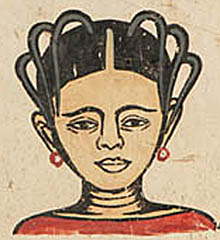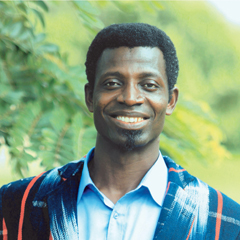Catching a glimpse of the feminine hairstyles (re)presentation in rows on a single support, brings to memory the barber salon promotional campaign artworks that served as visual displays to invite potential customers in parts of Africa in the past. Artists in the community were commissioned to create picturesque signages that display plethora of Afrocentric hairstyles on wooden boards and placed in front of hair salons or vantage points to attract potential clients. The artworks served as form of advertisements to the salon operators. Some itinerant hairstylists moved around with these signages in search of customers. The painted images have been replaced with printed catalogue of pictured hairstyles printed on large sheet of papers and flexy materials which are displayed in and outside salons in the communities. The picturesque hairstyles signage presented in this exhibition reminisces the artistic practice of creating these portraits as form of hair salon advertisement in Togo, Ghana, Nigeria and other West African countries.

Cutout from anonymous artist, second half of the 20th century, plywood, oilpaint, Image: Osuanyi Quaicoo Essel.
Uniformly arranged on a support, the artist presents fifteen Afrocentric feminine flashy plaited coiffures in portrait orientation. Of the fifteen hairstyles, one occupies the epicentral position of the entire composition in frontality of pose, depicting her full facial details in simple flat tone of brownish colour with the hair stylization rendered in black. Her rigged neck, pronounced eyebrow and bejeweled ears depicts her feminine characteristics. In Togolese culture, wearing of earring is a preserve of females as in the case of Ghana and some West African countries. The artist’s treatment of this centrally placed figure gives hint of Togolese feminine beauty standards. Four of the hairstyles are shown in side view, facing the left. Similar to these four figures in profile are the type-form head, rigged neck details and varying earrings. The rigged neck features found on these four figures also appear on the centrally placed figure in the composition. With this treatment, the artist makes visual notation of feminine beauty culture standards that characterised some West African countries. Rigged neck feature is considered as a marker of beauty ideal, and commonly depicted in West African feminine sculptures. For example, Akuaba (wooden doll, predominantly used as fertility figure), of Ghana is often armoured with rigged neck characteristics. Understanding the beauty culture ideals of Africa depicted in this simple but interesting hairstyles composition offers viewers of African art a better understanding of the art.
To reveal a great deal of the level of sophistication of the hair stylizations, the artist showed ten of the figures in back view posture, three each atop and down in horizontal placement, while four are arranged in a kite-shaped arrangement in the middle portions of the painting. The artist generates visual interest with the arrangement of the figures to create a sense of movement, variety and rhythm. For example, in the depiction of the clothing of the figures, shades of reds were used in a serpentine orderliness that forces the eyes to traverse gracefully upon a gaze from the topmost middle part to the down and vice versa. Similar colour treatment is achieved with shades of blue from the top left, moving in diagonal direction to far right of the middle portion of the painting, and orchestrating another diagonal turn towards the down left part. One striking feature that bedews the ten hairstyles in back view posture, is the skillful use of the negative and positive spatial relations that creates visual curiosity for deeper gaze of the hairstyles. With the exception of the blue-shirted figure on the last row of the composition, the remaining blue-shirted figures wear trumpet-shaped hairstyles with multi-sectional visual interests.
All the hairstyles represented by the artist are a reflection of the Afrocentric standardized beauty ideologies and practices inherent in the social environment of practice. These hairstyles make use of no hair extensions and or wigs; and are also practised in Ghana and other neighbouring countries. Females usually cared for their hair to grow long and plait it with black twine to form long narrow stripes which are then arranged in a particular manner by way of styling. Based on the society that wear them, the hairstyles may be given names and have symbolic meanings. The hairstyles portrayed are usually worn by the youthful and middle-aged females.
Colonialists’ invasion, slavery, Western religion, racial discrimination, amongst others, contributed to Black hair stereotyping which has caused some Black women to resort to hair beauty ideals of the colonialists. Historically, the discrimination resulted in some Black women who found themselves in foreign lands, hiding their hair by using coverings, especially, in public places. Some Black women use artificial chemicals to straighten their hairs to imitate the beauty ideals of the colonialists. Despite the counter-resistance to the stereotyping of Afrocentric hairstyling through civil right movements and visual (re)presentation by its practitioners and artists, many African women now wear extensions and wigs, a trend that raises the question of identity crisis and politics. The work of the artist in this context sheds light on the purely Afrocentric hairstyling culture of Togo and its neighbouring countries, and makes unapologetic statement of turning away from the colonial past.
The work brings into focus the need for fashion art educator and artists to join hands in contributing to institutional restructuring of teaching and learning of African fashion history including standardised beauty ideologies and ideals for reclamation of the past, and impenitent practice of Afrocentric beauty culture. Towards this end, teaching and learning should be focalised on the African cultural reorientation, concept of sankofaism (return to fetch the goodies of the past) and respect for one another irrespective of geography, skin colour, hair type or physique. Learners must be taught to build positive self-esteem and love for their culture, and demonstrate love for individual differences.
This article is part of a gallery: Perspectives from Ghana on Museum Objects in Germany
published January 2021


